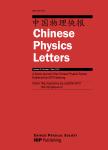版权所有:内蒙古大学图书馆 技术提供:维普资讯• 智图
内蒙古自治区呼和浩特市赛罕区大学西街235号 邮编: 010021

作者机构:CAS Key Laboratory of Strongly Coupled Quantum Matter Physicsand Department of PhysicsUniversity of Science and Technology of ChinaHefei 230026China International Center for Quantum Design of Functional Materials(ICQD)Hefei National Research Center for Physical Sciences at the MicroscaleUniversity of Science and Technology of ChinaHefei 230026China Hefei National LaboratoryUniversity of Science and Technology of ChinaHefei 230088China
出 版 物:《Chinese Physics Letters》 (中国物理快报(英文版))
年 卷 期:2022年第39卷第9期
页 面:57-61页
核心收录:
学科分类:081702[工学-化学工艺] 07[理学] 070205[理学-凝聚态物理] 08[工学] 0817[工学-化学工程与技术] 0702[理学-物理学]
基 金:supported by the National Natural Science Foundation of China(Grant Nos.92165201 and 11974324) the Innovation Program for Quantum Science and Technology(Grant No.2021ZD0302800) the Strategic Priority Research Program of Chinese Academy of Sciences(Grant No.XDC07010000) the Anhui Initiative in Quantum Information Technologies(Grant No.AHY170000) the Hefei Science Center CAS(Grant No.2020HSC-UE014) the Fundamental Research Funds for the Central Universities(Grant No.WK3510000013)
主 题:transport scattering boundary
摘 要:For conductors in the ballistic regime, electron-boundary scattering at the sample edge plays a dominant role in determining the transport performance, giving rise to many intriguing phenomena like low-field negative magnetoresistance effect. We systematically investigate the magneto-transport behaviors of BN-encapsulated graphene devices with narrow channel width W, wherein the bulk mean free path Lmfp can be very large and highly tunable. By comparing the magnetoresistance features and the amplitude of Lmfp in a large parameter space of temperature and carrier density, we reveal that the boundary-scattering-dominated negative magnetoresistance effect can still survive even when the ballistic ratio(Lmfp/W) is as low as 0.15. This striking value is much smaller than the expected value for achieving(quasi-) ballistic transport regime(Lmfp/W ≥ 1), and can be attributed to the ultra-low specularity of the sample edge of our graphene devices. These findings enrich our understanding of the effects of boundary scattering on channel transport, which is of vital importance for future designs of two-dimensional electronic devices with limited lateral sizes.